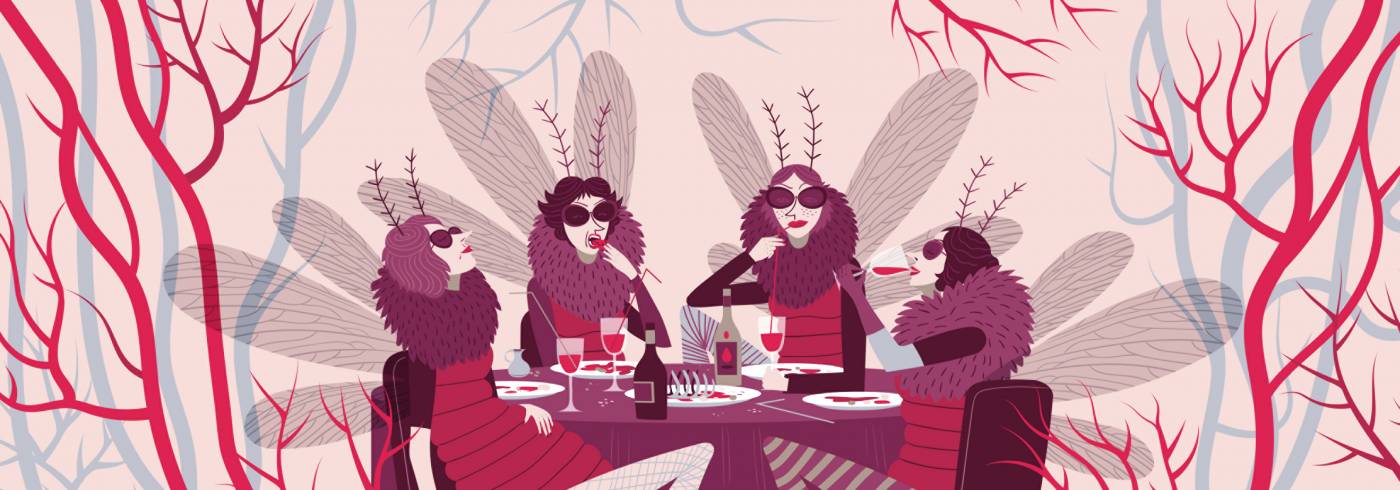New findings could make mosquitoes more satisfied—and safer to be around

“No thanks, I’m stuffed.” (Illustration by Federica Bordoni)
She weighs less than one ten-thousandth of an ounce and her top speed is less than two miles per hour. Nonetheless, the female mosquito is one of the most dangerous animals on the planet. For as she flies from person to person, biting us to draw the blood she needs to lay her eggs, this tiny creature transmits microbes that sicken and kill millions of people every year.
Recently, however, scientists in the lab of Leslie B. Vosshall have shown that female mosquitoes can be persuaded not to bite at all. Their work, which appears in the journal Cell, illuminates the biology underlying the host-seeking and blood-feeding behaviors that make these insects such a menace—and could lead to new ways of shutting those behaviors down.
A bloated mosquito is a safe mosquito
The researchers conducted their experiments on Aedes aegypti mosquitoes, the species responsible for spreading dengue, Zika, chikungunya, and yellow fever.
Female Aedes are fiercely attracted to human beings, whose blood contains the protein they need to produce their eggs. Yet once they have fed, that attraction declines precipitously, and the bloated mosquitoes show little interest in seeking another blood meal for several days.
“It’s like the ultimate Thanksgiving dinner,” says Laura Duvall, the postdoctoral fellow who led the project.
Scientists can reproduce that long-term postprandial effect by injecting female mosquitoes with large doses of small protein-like molecules called neuropeptides, which activate specialized receptors. But the list of possible neuropeptide-receptor combinations is long, and better tools were needed to develop compounds that could more efficiently suppress a female’s feeding behaviors without having other, unwanted effects.
Fortunately, similar receptors regulate feeding behavior in many species, including our own. And that shared evolutionary inheritance provided Duvall and her colleagues with the clue they needed to solve the mystery of the mosquito’s missing appetite.
Appetite suppressant
In humans, so-called Neuropeptide Y or NPY receptors regulate food intake, and the pharmaceutical industry has developed anti-obesity drugs that both activate and inhibit them.
Duvall and her colleagues reckoned the same drugs might affect the mosquitoes’ NPY-like receptors, as well. And they were right.
When the researchers fed female mosquitoes saline solution doped with drugs that activate human NPY receptors, the insects’ attraction to a human host—as measured by their willingness to fly towards a bit of nylon stocking that Duvall had worn long enough to absorb the bodily odors that scream “mealtime” to mosquitoes—plummeted just as if they had had a blood meal. Alternately, when the researchers fed the mosquitoes blood doped with a drug that inhibits the same receptors, they behaved as if they had not eaten at all.
To pinpoint the particular receptor that the human drugs were acting upon, the team used their knowledge of the mosquito genome to clone all 49 of the species’ possible neuropeptide receptors and exposed them to the same compounds. Only one, an NPY-like receptor known as NPYLR7, responded to all the human drugs that had affected the mosquitoes.
“We were impressed and amazed that drugs designed to affect human appetite worked perfectly to suppress mosquito appetite,” said Vosshall, Robin Chemers Neustein Professor.
What’s more, when the team fed blood to mutant Ae. Aegypti that had been genetically engineered to lack proper NPYLR7 receptors, those mosquitoes remained as interested as ever in their next meal—confirming that NPYLR7 was indeed the receptor they had been looking for.
Use only as directed
At that point, the researchers knew that NPYLR7 might be what they have long sought: a means of preventing mosquitoes from biting people. But the human drugs they used to manipulate the receptor in the lab wouldn’t be suitable for use in the wild, where they might affect people as well as mosquitoes.
Instead, they began searching for molecules that would selectively activate NPYLR7 without triggering human NPY receptors. Starting with an initial list of more than 250,000 candidates, the team ultimately settled on “compound 18”—a molecule that suppressed Aedes’ host-seeking behavior with no off-target effects.
Demonstrating that a drug will cause female mosquitoes to turn up their noses at a piece of tasty-smelling nylon is one thing, however. Proving that it will prevent them from biting a living, breathing host when it is laid out in front of them like a Thanksgiving turkey is another.
So for their final test, the researchers let the mosquitoes loose on a live mouse. (While Aedes prefer humans, they will make do with other mammals when necessary.) Much to their satisfaction, mosquitoes that were fed compound 18 were as disinterested in feeding on the rodent as mosquitoes that had enjoyed a full-blown blood meal.
A bite-free future?
The team’s findings have far-reaching implications, both for future research and for vector control.
Now that the researchers know which receptor is responsible for switching off Ae. Aegypti’s host-seeking and biting behaviors, they can begin to identify where it is produced in the insect’s body, and when it might be naturally activated by chemicals that the mosquitoes produce themselves. (Although they still do not know exactly which naturally occurring neuropeptides activate NPYLR7, Duvall and her colleagues now have a list of nine possible candidates.) That, in turn, will help them trace the larger neural circuits that govern the mosquito’s feeding behavior.
At the same time, their results suggest a new strategy for reducing the transmission of mosquito-borne diseases—and perhaps ailments spread by other insects, as well.
With a bit of luck, medicinal chemists could refine compound 18 to produce an even more potent molecule that could be delivered to female mosquitoes in the wild through baited traps, or through the semen of male mosquitoes that have been genetically modified to produce it themselves.
Muzzling Ae. Aegypti would be a boon in and of itself. But other blood-feeding, disease-carrying arthropods, including the mosquitoes that spread malaria and the ticks that transmit Lyme disease, also possess NPY-like receptors. It seems likely that a compound that suppresses Ae. Aegypti’s feeding behaviors would suppress theirs, too.
And that would take a significant bite out of the global disease burden imposed by these pernicious blood-suckers.



